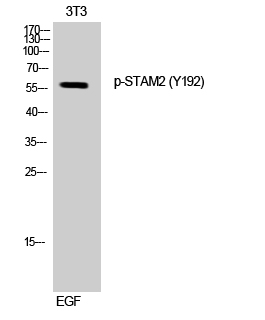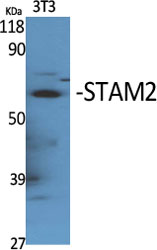STAM2 (phospho Tyr192) Polyclonal Antibody
- Catalog No.:YP0399
- Applications:WB;IHC;IF;ELISA
- Reactivity:Human;Mouse
- Target:
- STAM2
- Fields:
- >>Endocytosis;>>JAK-STAT signaling pathway
- Gene Name:
- STAM2
- Protein Name:
- Signal transducing adapter molecule 2
- Human Gene Id:
- 8986
- Human Swiss Prot No:
- O75886
- Mouse Gene Id:
- 56324
- Mouse Swiss Prot No:
- O88811
- Immunogen:
- The antiserum was produced against synthesized peptide derived from human STAM2 around the phosphorylation site of Tyr192. AA range:161-210
- Specificity:
- Phospho-STAM2 (Y192) Polyclonal Antibody detects endogenous levels of STAM2 protein only when phosphorylated at Y192.
- Formulation:
- Liquid in PBS containing 50% glycerol, 0.5% BSA and 0.02% sodium azide.
- Source:
- Polyclonal, Rabbit,IgG
- Dilution:
- WB 1:500 - 1:2000. IHC 1:100 - 1:300. ELISA: 1:10000.. IF 1:50-200
- Purification:
- The antibody was affinity-purified from rabbit antiserum by affinity-chromatography using epitope-specific immunogen.
- Concentration:
- 1 mg/ml
- Storage Stability:
- -15°C to -25°C/1 year(Do not lower than -25°C)
- Other Name:
- STAM2;HBP;Signal transducing adapter molecule 2;STAM-2;Hrs-binding protein
- Observed Band(KD):
- 58kD
- Background:
- The protein encoded by this gene is closely related to STAM, an adaptor protein involved in the downstream signaling of cytokine receptors, both of which contain a SH3 domain and the immunoreceptor tyrosine-based activation motif (ITAM). Similar to STAM, this protein acts downstream of JAK kinases, and is phosphorylated in response to cytokine stimulation. This protein and STAM thus are thought to exhibit compensatory effects on the signaling pathway downstream of JAK kinases upon cytokine stimulation. [provided by RefSeq, Jul 2008],
- Function:
- domain:Contains one Pro-Xaa-Val-Xaa-Leu (PxVxL) motif, which is required for interaction with chromoshadow domains. This motif requires additional residues -7, -6, +4 and +5 of the central Val which contact the chromoshadow domain.,domain:The SH3 domain mediates the interaction with USP8.,domain:The VHS and UIM domains mediate the interaction with ubiquitinated proteins.,function:Involved in intracellular signal transduction mediated by cytokines and growth factors. Upon IL-2 and GM-CSL stimulation, it plays a role in signaling leading to DNA synthesis and c-myc induction. May also play a role in T-cell development. Involved in down-regulation of receptor tyrosine kinase via multivesicular body (MVBs) when complexed with HGS (ESCRT-0 complex). The ESCRT-0 complex binds ubiquitin and acts as sorting machinery that recognizes ubiquitinated receptors and transfers them to further sequential
- Subcellular Location:
- Cytoplasm . Early endosome membrane ; Peripheral membrane protein ; Cytoplasmic side .
- Expression:
- Ubiquitously expressed.
- June 19-2018
- WESTERN IMMUNOBLOTTING PROTOCOL
- June 19-2018
- IMMUNOHISTOCHEMISTRY-PARAFFIN PROTOCOL
- June 19-2018
- IMMUNOFLUORESCENCE PROTOCOL
- September 08-2020
- FLOW-CYTOMEYRT-PROTOCOL
- May 20-2022
- Cell-Based ELISA│解您多样本WB检测之困扰
- July 13-2018
- CELL-BASED-ELISA-PROTOCOL-FOR-ACETYL-PROTEIN
- July 13-2018
- CELL-BASED-ELISA-PROTOCOL-FOR-PHOSPHO-PROTEIN
- July 13-2018
- Antibody-FAQs
- Products Images

- Western Blot analysis of 3T3 cells using Phospho-STAM2 (Y192) Polyclonal Antibody

- Enzyme-Linked Immunosorbent Assay (Phospho-ELISA) for Immunogen Phosphopeptide (Phospho-left) and Non-Phosphopeptide (Phospho-right), using STAM2 (Phospho-Tyr192) Antibody

- Western blot analysis of lysates from NIH/3T3 cells treated with EGF 200ng/ml 30', using STAM2 (Phospho-Tyr192) Antibody. The lane on the right is blocked with the phospho peptide.

- Immunohistochemical analysis of paraffin-embedded human tonsil. 1, Antibody was diluted at 1:200(4° overnight). 2, Tris-EDTA,pH9.0 was used for antigen retrieval. 3,Secondary antibody was diluted at 1:200(room temperature, 30min).



